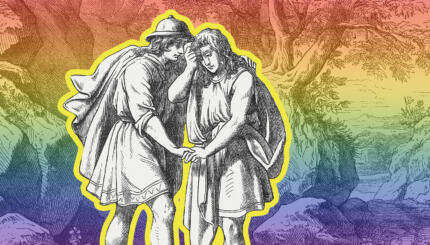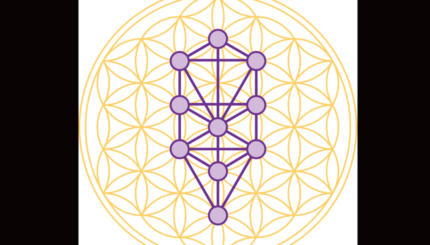I’m writing this as the father of a transgender child, who feels constricted in a space too narrow to accept my child and so many of God’s children as equals. I’m also frustrated, as someone who identifies as some version of traditional, at how small we have made the Torah and the limits that we have put on God and holiness. It’s my intention that by expanding Torah thoughts we can get closer to understanding how big and inclusive the Torah really is.
It’s not good for humans to be alone because we are created in the image of God and it isn’t good for God to be alone. Was the void that God felt in the beginning when there was no one to see or try to understand God, so different from our feelings of loneliness or our need to be held and understood? Our struggle to find a place to belong and be loved for who we are isn’t just a part of the human experience, but rather it echoes the Divine.
The Book of Genesis opens with a large Hebrew letter bet (ב), beginning the first word of the Torah, “בראשית” (Genesis). The letter bet is formed by connecting a vertical line with two horizontal lines. These three lines represent a unifying act of construction. Two parallel lines can be extended forever, but they will always need a third line to bring them together: finding commonality among differences is the framework of every partnership, including God’s relationship with us. When we spell out the letter bet in Hebrew we get the word “בית,” meaning house. Perhaps the Torah starts with this letter to teach us that we are all guests in God’s house.
There is another unifying aspect of the letter bet in “בראשית” as a prefix to the rest of the Torah’s first word “ראשית,” meaning beginning or first. Usually only one thing can be considered first in any category, but our tradition teaches that there are actually three firsts; God, Torah, and the Jewish people. The Zohar writes that all three are connected and in truth, all three are the same. The bet alludes to this concept when we see it as the letter and simultaneously, as three lines or three of the letter “ו”s that form the “ב.”
In Hebrew, the word for the word “and” exists only as the prefix “ו,” pronounced vuv. Its job is to connect one thing and another. The vuv gets it name from the ווי, the hooks in the tabernacle that connected the curtains to the pillars. Indeed, the letter, when written properly, looks like a hook. There are three different ways that we find the letter vuv spelled out: “וא׳׳ו” “,וי׳׳ו,” and “ו׳׳ו” with corresponding numerical values of 13, 22, and 12. These allude to the oneness of the Creator, (אחד), the twenty two letters of the Hebrew alphabet in which the Torah was written, and the twelve tribes of Israel. God, Torah, and the Jewish people coming together as one supportive structure.
It is perhaps not coincidental that when Cain finds himself an exiled wanderer feeling afraid, vulnerable, and exposed, the sign that God places on his forehead is the connecting letter vuv “ו.”The Hebrew word for life or soul, neshama “נשמה,” is the same as the word for barren or desolate. The only distinction between these two very opposing meanings is the vowel under the shin“ש.” The negative meaning has only the vowel “-” where the positive also has a vuv “ו.” The difference between feeling alive and feeling the opposite is the support of being part of something.
Each one of us is a different letter that reflects God’s image. If a Torah is missing even one letter, it’s invalid and can’t be used. If even one person is missing, we as a people, as humanity, are incomplete and God’s glory is diminished. May we support the commonality of individuality and expand the walls of God’s house to make this world a welcoming place for all of us and God.
This post is part one of a series for Transgender Day of Remembrance.
Torah
Pronunced: TORE-uh, Origin: Hebrew, the Five Books of Moses.


